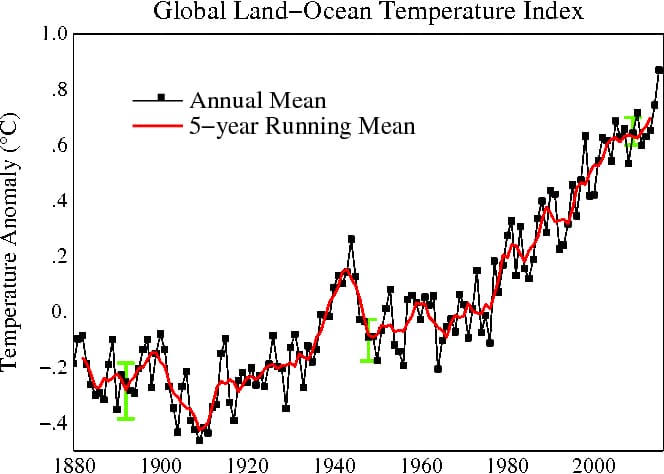From hot to fractionally less hot, here are the planet’s ten warmest years on record – 2015, 2014, 2010, 2005, 2007, 2013, 2009, 1998, 2002 and 2006.
These are the numbers according to NASA and include measurements taken on land and at sea in a record that goes back to the year 1880.
Now that’s a pretty remarkable run of hot years for an era when, according to the rusted-on professional climate science denialists, global warming was supposed to have stopped.
But what are the chances of getting a run of “hottest on record” years like that – 14 of the 16 hottest years all happening since 2000 – without all the extra greenhouse gases that humans have been judiciously stockpiling in the atmosphere and oceans?
Well, the chances of this happening, climate scientist Professor Michael Mann tells me, are… wait for it… one-in-13000. Mann, of Penn State University, is the lead author of a new paper published in Nature’s Scientific Reports.
The study takes in data up to 2014, when the chance of that hot streak was one-in-10000. Since the study was submitted, Mann has re-run the numbers to include the new “hottest year” of 2015, giving us the one-in-13000 number.
The study looks at how likely (or unlikely) it would be that the planet could serve up a string of hot years without human influence.
There are several natural factors that can push global temperatures up or down, such as the amount of energy coming from the sun, the El Nino/La Nina cycle and volcanic eruptions.
Then of course, there’s the human influence – chiefly, the extra greenhouse gases in the atmosphere from burning fossil fuels and chopping down forests.
Mann and his colleagues took a computer climate model and ran it one million times, creating a series of “surrogate” climates from 1880 to 2014 allowing for a huge range of different background conditions. Then they looked at what those climates would look like if you only removed the greenhouse gases added by human activity.
Mann has a longer explanation of his study at Live Science where he discusses some more results.
A key motivation for the study was to examine more closely claims made elsewhere that the chances of a record run were even slimmer – 27 million-to-one according to a report in Salon or 650 million-to-one according to a report from Associated Press.
The main reason why Mann’s numbers are different, is that those reports of much longer odds used a method that did not account for how natural factors – such as El Nino or volcanic eruptions – have an impact on surrounding years, rather than just one single year.
But Mann explains that even with the method used in his latest study, the chances of a climate without human influences delivering individual years as hot as 1998, 2005, 2010, and 2014 were at least a million to one.
Doubts remain
Many members of the public in westernised English speaking countries are still split on the causes of climate change. While increasing numbers accept climate change is real, in the mind of the public there’s still uncertainty about whether it’s natural or human-caused.
In Australia, according to a CSIRO survey (with a comparatively large sample of 5000 people), about 39 per cent of Australians agree that climate change is happening but think that it’s causes are natural.
But does this mean that the chances of that 39 per cent of people being right, are about one-in-13000?
“Well, frankly that would actually be rather charitable,” Mann told me. “That is the likelihood of that particular statistic being explainable in terms of natural climate variability. But we also looked at other statistics, such as, how easily can we explain “how warm” 2014 or 2015 was globally. And in each case, we find that the odds are less than one-in-a-million.”
“So regardless of how you parse our study – or the collective evidence from other studies for that matter – the evidence is overwhelming that the observed warming of the planet can only be explained by the increase in greenhouse gas concentrations from fossil fuel burning and other human activities.”
One key contributor to the heat of 2015 was the cycle of ocean temperatures in the tropical Pacific Ocean that can have a global impact on weather patterns and temperatures – a pattern known as El Nino.
Professional climate science denialist Patrick Michaels, of the Cato Institute, tried to argue in the Wall Street Journal that the chief cause of the record-breaking temperatures of 2015 was El Nino.
Once El Nino drops off, as it likely will in the coming months, Michaels said temperatures would drop away. This is also likely, especially if we get La Nina conditions (generally speaking, having the opposite effect of El Nino).
But Michaels does not explain how the global warming trend continues to rise, regardless of whether a year is La Nina or El Nino, as this chart below from NASA shows.
Michaels also suggested to his readers that people should not trust the temperature data taken by thermometers on the surface of the planet, but should instead rely on temperatures taken by satellites.
Satellite data shows that 2015 was the third hottest since 1979, when satellite data first became available.
Michaels does not explain to his readers that satellite data goes through far greater adjustments than ground-based measurements.
Even the scientist who compiles one of the major satellite datasets says that ground-based measurements are better when talking about climate change.
Some ten scientists at Climate Feedback have fact-checked Michaels column and gave it a scientific credibility rating of “very low”.
Or to think about it another way, the chances of Michaels being right are roughly the same as the chance of the world going on a record-breaking heat run without all that extra carbon dioxide in the atmosphere.
Vanishingly slim.
Subscribe to our newsletter
Stay up to date with DeSmog news and alerts







